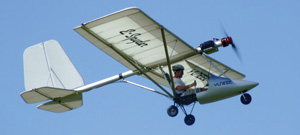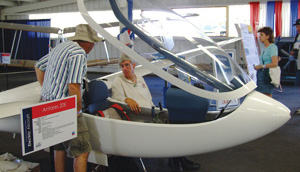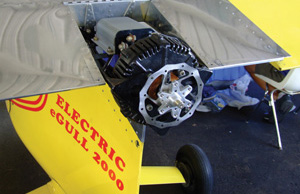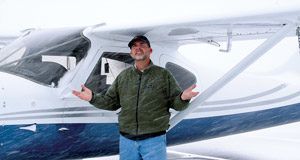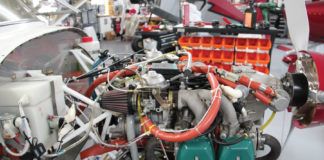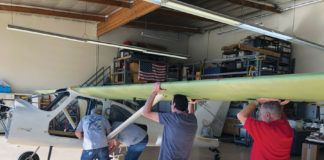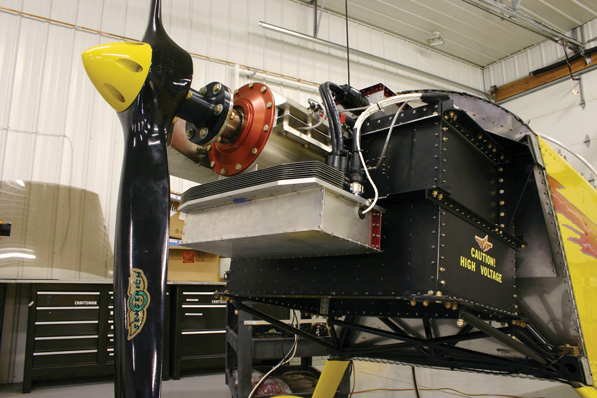
Work is underway to develop an electric Waiex aircraft powered by this 270-volt, 200-amp motor. Its estimated the airplane will be able to cruise at 70 mph on 30% power for an hour.
Its a new era. Increasing concerns about fuel availability and cost are being met with encouraging technological advances, especially in the field of electric-powered aircraft. Right now, momentum is building for these aircraft as technology-driven by the auto industry and other users of electric motivation-makes them ever more viable. Many feel that the electric aircraft is a sure solution to save general aviation.
But what exactly is an electric-powered aircraft, and how would it work? Lets first look at the history and the technology behind this movement, and then take a glimpse at what the future may hold. (KITPLANES Editor at Large Dave Martin, just back from AirVenture, offers a brief report on what appeared at the show on Page 17.)
Just for fun, though, lets start with a few predictions. In the next five years, before 2015, I predict:
- An electrically powered plane will stay aloft for 2 hours with two people.
- An electrically powered airplane will be cost competitive with Light Sport Aircraft and trainers.
- Electric airplanes will be powered by batteries with energy densities at least 50% better than what is available today.
- An electric airplane will land at an airport near you.
The state of the art in this field is advancing so rapidly that there are sure to be announcements soon that may make these predictions seem conservative.
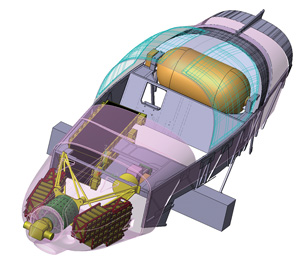
The SkySpark design is a fuel-cell hybrid that reached 155 mph in testing.
Definition of an Electric Airplane
Development in this field has been so quick that there is no firm definition of an electric airplane, so here is mine: An electric airplane is a human-carrying, heavier-than-air vehicle with the motive force supplied by an electric motor. The motor might get its electrical energy from batteries, solar collectors, fuel cells or a combination of these (one old-timer mechanic suggested a long extension cord). An electric airplane might be a motorglider that gains lift from thermals and updrafts and uses a motive force only periodically, or it might use the motor for continuous power. Further, it might also use electric power for lift as does an electric helicopter (not that I know of anyone who has tried this, but I am sure someone is out there considering it). A little on the gray side of this definition are airships. To me these are not airplanes, yet an electric airship flew in 1884, a remarkable feat. Finally, electric airplanes may also be capable of regeneration, regaining energy for storage by descending, decelerating or circling in thermals.
History
My definition includes heavier than air, and its worth looking at an airship, the La France, designed by Albert Constantin Krebs and Charles Renard. The LaFrance was 167 feet long and from 1884 to 1885 made seven flights. Five of these were round trips-the first for any kind of aircraft. Its longest flight was 5 miles, which the ship covered in 23 minutes. The electric motor was 9 horsepower, and the batteries 970 pounds, giving the La France 108 pounds/hp. Krebs was the technologist for the La France, and is a fascinating man with many inventions to his credit.
Little happened in electric airplane technology until the late 1970s when Larry Mauro built a solar-powered hang glider called the Solar Riser. The solar energy stored in its battery could power it for 3 to 5 minutes, enough to launch it to gliding altitude. In 1981, the Solar Challenger, built by Paul MacCreadys AeroVironment Company, successfully completed a 163-mile man-carrying and record-breaking flight from France to England. The Solar Challenger had an empty weight of 200 pounds, and the 16,128 cells powered two 3-hp motors using solely photovoltaic cells that covered its wing and stabilizer. It had no batteries onboard and would slow down if passing under a cloud.
MacCready also developed unmanned electric aircraft such as the Pathfinder and Helios for NASA during this period. These aircraft (there were five of them) were powered by from six to 14 2-hp motors mounted in pods on a single flying wing. They were designed for high-altitude loitering with the solar cells collecting energy during the day to run the motors and recharge the lithium-ion batteries for uninterrupted flight at night. This series culminated with the Helios, which had a wingspan of 247 feet and flew to 95,000 feet. The Pathfinder-Plus is now on display at the Smithsonians Steven F. Udvar-Hazy Center at Dulles Airport.
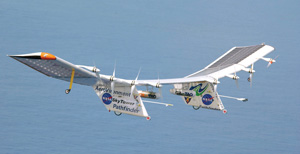
Paul MacCreadys Pathfinder ran its eight electric motors from lithium ion batteries recharged by solar cells atop the wing.
Seeking the Sun
In 1990, Eric Raymond flew the Sunseeker across the United States much as the Wright VinFiz was flown across in 1911, that is, in short hops. The Sunseeker was a purpose-built solar motorglider that could take off and climb under power and then soar while recharging. It could fly up to 150 miles on solar and batteries, and Raymond also logged flights of 250 miles with additional thermal hopping. It was powered by an 8-hp brushless DC motor. In 2002, Sunseeker II was launched with many improvements. It is now on a tour of Europe, and earlier this year it became the first solar-powered aircraft to cross the Alps, 99 years after the Peruvian pilot Georges Chavez did so in a Bleriot. Sunseeker II has a gross weight of 506 pounds and a span of 56 feet.
At AirVenture 2008, two hits were based on John Monnett airplanes: Randal Fishmans ElectraFlyer-C (an electric Moni) and the E-Flight Initiatives Waiex. The ElectraFlyer-C was designed as a prototype and based on a converted Moni motorglider. Fishman has founded the Electric Aircraft Corporation to develop and sell power systems for electric aircraft.
The ElectraFlyer-C is powered by an 18-hp (13.5 kW) electric motor, a pulse width modulation controller, and a 5.6 kWh lithium ion battery pack. It flies for 1 to 1.5 hours at a cruise speed of 70 mph with a max speed of 90 mph. Empty weight (with batteries) is 380 pounds, and max takeoff weight is 625 pounds. In a future issue, well explore the meaning and interrelationship of these values.
The E-Flight Initiative is focused on developing motors and controllers for electric aircraft. Working with John Monnett, the E-Flight Initiative folks are developing an electric Waiex, powered by a 270-volt, 200-amp, brushless DC motor. It carries 200 pounds of lithium ion batteries and is designed to cruise at 70 mph using 30% power (4.5 kW) for an hour or to do acrobatics for 15 minutes. The design team has also been developing high-voltage and -amperage power inputs for a new system.
New Designs
In June 2009, the SkySpark made its first public appearance. The SkySpark is a Turin Polytechnic University project aided by many technical sponsors. The SkySpark teams goal is to design and build a high-performance, single-seater able to fly at 186 mph for more than 2 hours. In the June 2009 flights, the aircraft was powered solely by batteries, but it is designed as a fuel-cell powered airplane with batteries only for auxiliary power. During these test flights it reached a top speed of 155 mph, a record (so they claim) for a 100% electrically powered aircraft. It is powered by a 75-kW electric motor using brushless technology and lithium polymer batteries.
The team is now focusing on the fuel-cell system, designed to produce 60 kW of power from 5.8 gallons of stored liquid hydrogen. Hydrogen is stored in a tank behind the pilot. The fuel cells are in the copilot position, and batteries are under the cowling, alongside the motor.
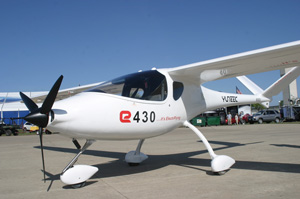
The Yuneec E430 from China appeared last June. Its LSA eligible, and may fly for 2.5 hours on a charge.
Also in June, the Yuneec E430, a 54-hp two-seat Chinese electric airplane made its first public appearance. What makes it unique (pun intended) is that it is the first electric aircraft designed to be commercially produced. The E430 is a Light Sport Aircraft that seats two and is made with lightweight composites. The 230-volt powerplant charges in 3 hours, and the manufacturer claims the plane will be able to fly for about 2.5 hours on a single charge. It will sell for $89,000.
Finally, in June (a busy month), the SolarImpulse was unveiled. This solar-powered airplane is meant to fly around the world powered only by the sun.
The CAFE Electric AC Symposium III
I was fortunate enough to attend the third CAFE Electric Aircraft Symposium, held at the Hiller Aviation Museum in San Carlos, California, on April 24, 2009. The estimated 150 attendees heard 15 presentations during the full and interesting day. Talks started with climate science and then focused on battery, controller and motor technology, ending with presentations about various aircraft designs, both real and imagined. Unfortunately, no electric airplanes were brought to the event.
There seemed to be general agreement among the speakers that the key to a successful electric airplane is increased battery energy density. Energy density is a measure of the amount of energy that can be stored divided by the weight. Generally units like watt-hours per pound or kilogram of weight are used. Where lead-acid batteries have a density of about 30 watt-hour/kg and NiCads have 40 watt-hour/kg, lithium ion batteries have 120 to 185 watt-hour/kg, and the capacity is increasing at 8% to 10% per year. Where current batteries seem sufficient only for motorgliders or light, single-place aircraft making short flights, increased battery energy density encouraged many at the symposium to dream of more complex aircraft. This led to my earlier predictions.
One of the most refined electric airplanes discussed was the Antares 20E, a motorglider that has impressive performance, a very high price tag and an interesting motor turned inside out. The center portion of the motor is hollow for air cooling and fixed to the aircraft, while the rotor acts as a case with the propeller blades mounted directly to it-an out-runner configuration.
Two speakers working on similar motorglider designs are Greg Cole of Windward Performance and a team at the University of Stuttgart. Both presented details about their efforts. At the end of the day most participants left with ideas about what it will take to make a practical electric aircraft.
Aviation Green Prize
The high point for many of the attendees was the announcement of the Aviation Green Prize (officially the 2011 CAFE Aviation Green Prize Challenge), which is a $1.65 million prize cosponsored by the CAFE Foundation and NASA (only U.S. citizens are eligible) and allows for any type of aircraft, but those in the audience were all thinking electric or hybrid. The goal is to develop an aircraft before July 2011 that can cover 200 s.m. at more than 100 mph with better than 100 miles per equivalent gallon of gasoline.
The 2011 Challenge is meant to encourage the development of new technologies for small aircraft that are potentially applicable to unmanned aerial vehicles (UAVs), air-taxi operations, homeland security surveillance and personal transportation. New technologies that may be competitive include, but are not exclusively limited to, electric airplanes. The score for each aircraft is a function of miles per hour, number of passengers carried, and MPGe (the equivalent miles per gallon relative to 87 octane regular unleaded auto gasoline).
The equation to calculate the score is: Passenger MPGe = number of passengers (pilots, passengers or seats with equivalent ballast) multiplied by the calculated vehicle miles per gallon equivalent for the fuel and/or electricity referenced to the average energy content of 1 gallon of gasoline. For example, if there are two passengers and the airplane gets 100 MPGe, then Passenger MPGe = 200. Further, if the plane averages 100 mph over the course, then the total score is 50.
| Fuel type | BTU per gallon | Density lb/gal | Energy ratio to 87 octane |
| 87, 89, 91 unleaded autogas | 115,000 | 6.09 | 1.0 |
| Biodiesel B20 | 127,250 | pending | 1.1065 |
| Avgas 100LL | 120,000 | 6.02 | 1.0435 |
| Petro-diesel | 129,500 | 7.09 | 1.1261 |
| Hydrogen, liquid | 34,644 (51,532/lb) | 0.567 | 0.3013 |
| Electricity: mi/kWh | N/A | N/A | 33.703 kWh per gallon |
To see what this means for an electric airplane or some other technology, consider Table 1, which contains data from the CAFE web site. Say you flew an electric airplane that had 66 kWh of energy stored in batteries. In terms of 87-octane gasoline, this is about 2 gallons (66/33.703) and the MPGe is 100 as in the previous example. To get a feel for 66 kWh of energy, consider that your car battery can store about 1.0 kWh. However, there are battery packs that can provide this amount of energy for a more reasonable size and weight.
Other rules are summarized here. (For full details refer to the Aviation Green Prize web site listed in Resources.)
- Passengers: Upright seats with adequate volume for a 6-foot-tall, 200-pound adult.
- Efficiency: ≥ 200 Passenger MPG energy equivalency.
- Speed: ≥ 100 mph average over the racecourse.
- Range: 200 miles with FAR mandated reserves (30 minutes).
- Minimum speed: ≤ 52 mph in level flight without stall.
- Takeoff distance: ≤ 2000 feet from brake release to clear a 50-foot obstacle on takeoff.
- Community noise: ≤ 78 dBA at full-power takeoff, measured 250 feet perpendicular to point of brake release.
- Wingspan: Must fit inside 44-foot-wide hangar for weighing.
- Vehicle weights: ≤ 6500 pounds on maingear and ≤ 2000 pounds on nosewheel or tailwheel .
- Payload carried: 200 pounds per seat. Dual pilots if two or more seats. 200 pounds per seat sandbag ballast in all seats not occupied by pilot/copilot.
For electric-powered aircraft, a power meter, provided at the competition, will accurately determine energy used during the race.
The registration fee is $4000 before November 30, 2009, and $6000 after. A maximum of 12 competitors will be accepted.
In Closing
Things are happening fast. As reported by Dave Martin from Oshkosh, the SkySpark and Yuneec made their public appearances, and there will be more interesting hardware coming to this fledgling but rapidly growing industry. For now, Ill stick with my predictions, and I expect you will be seeing and flying electric airplanes soon.

